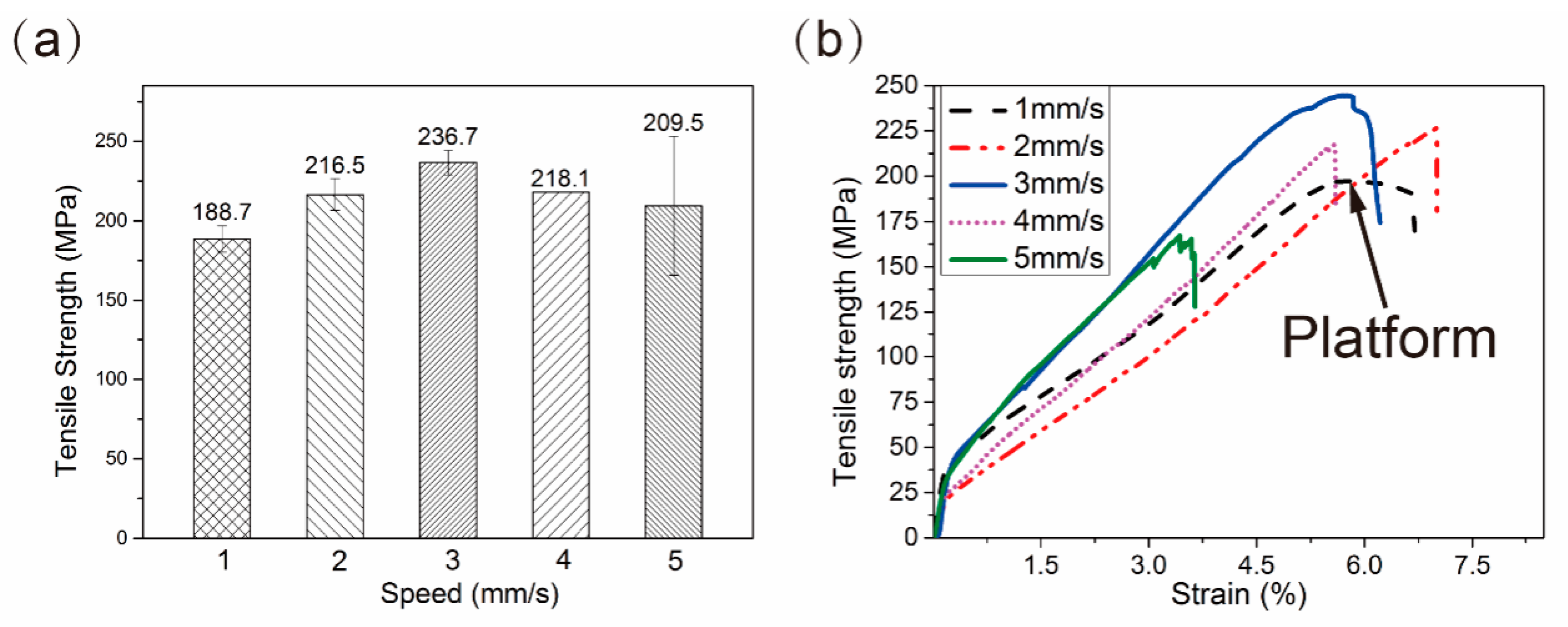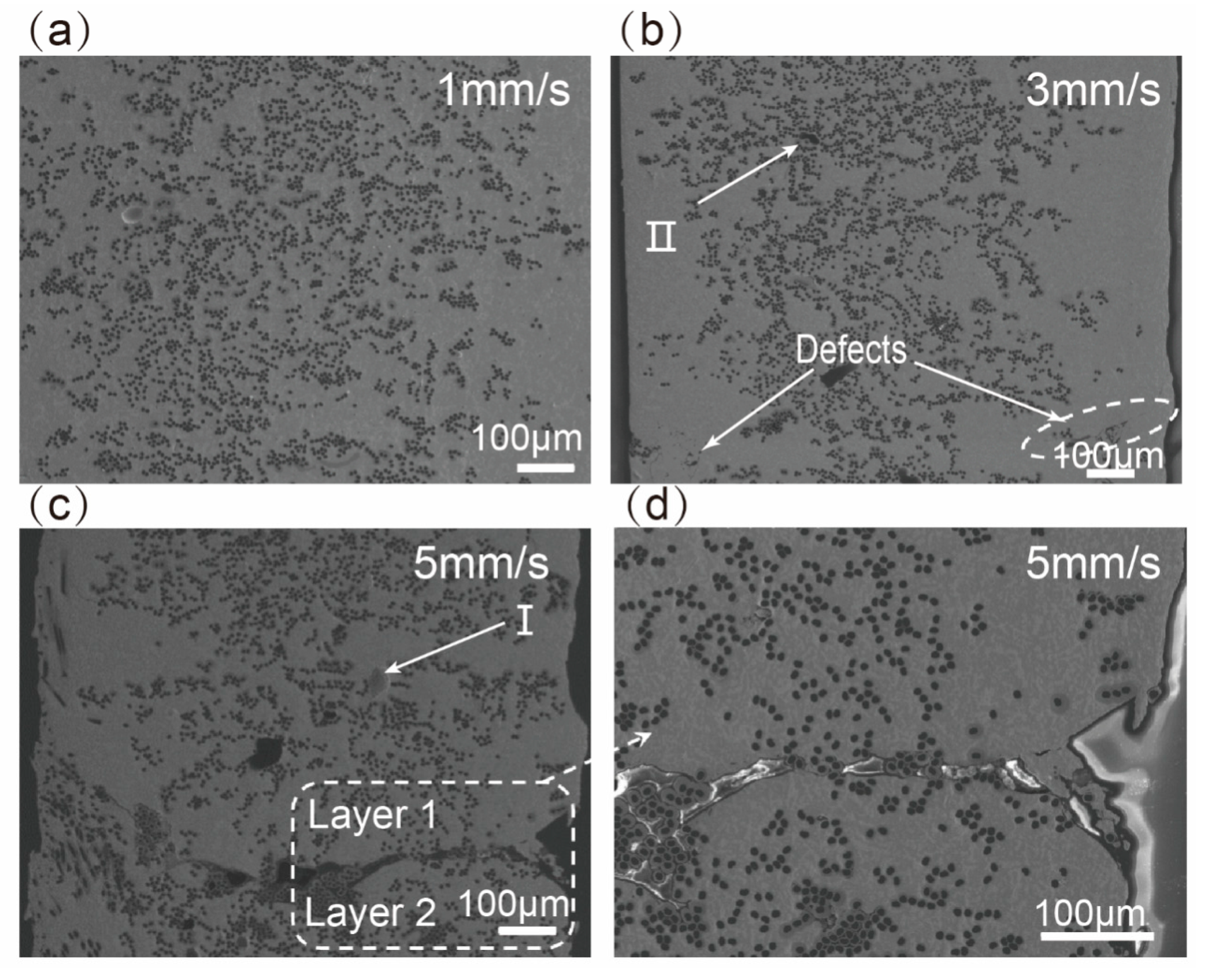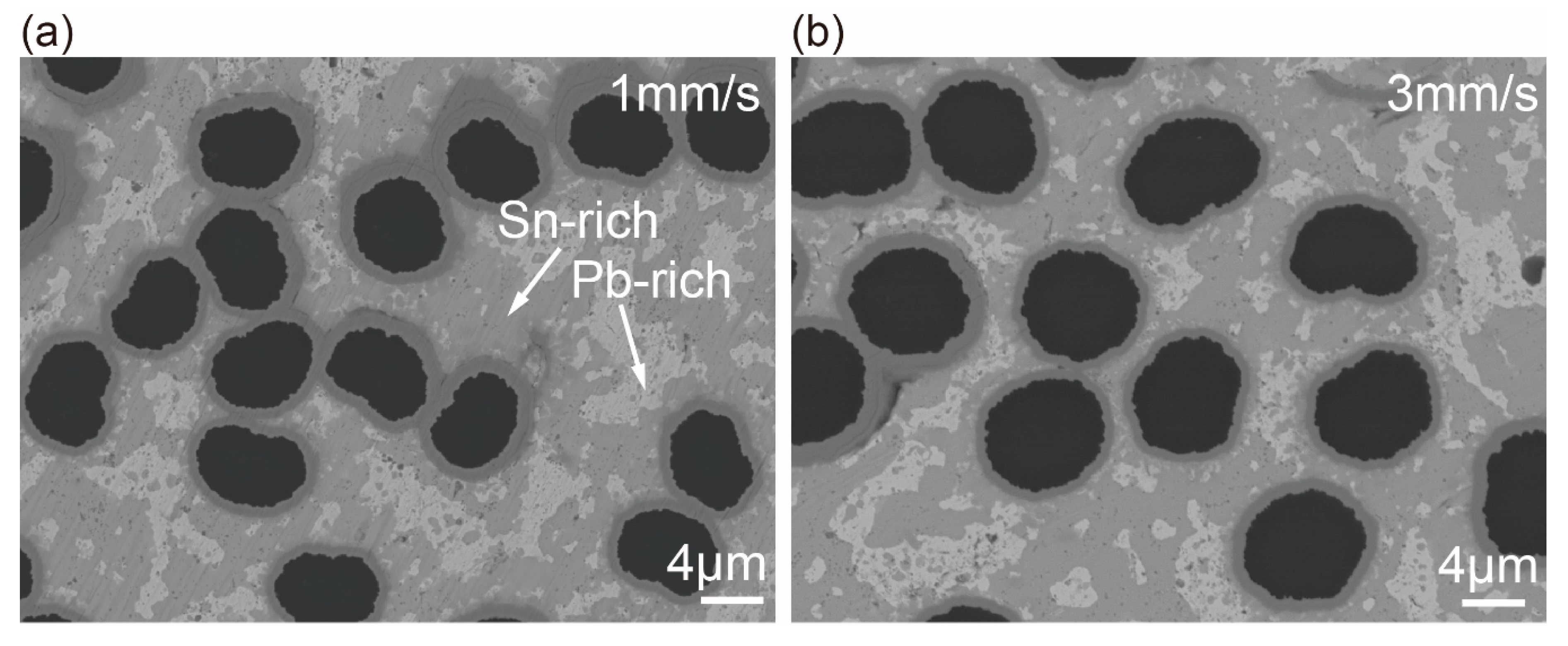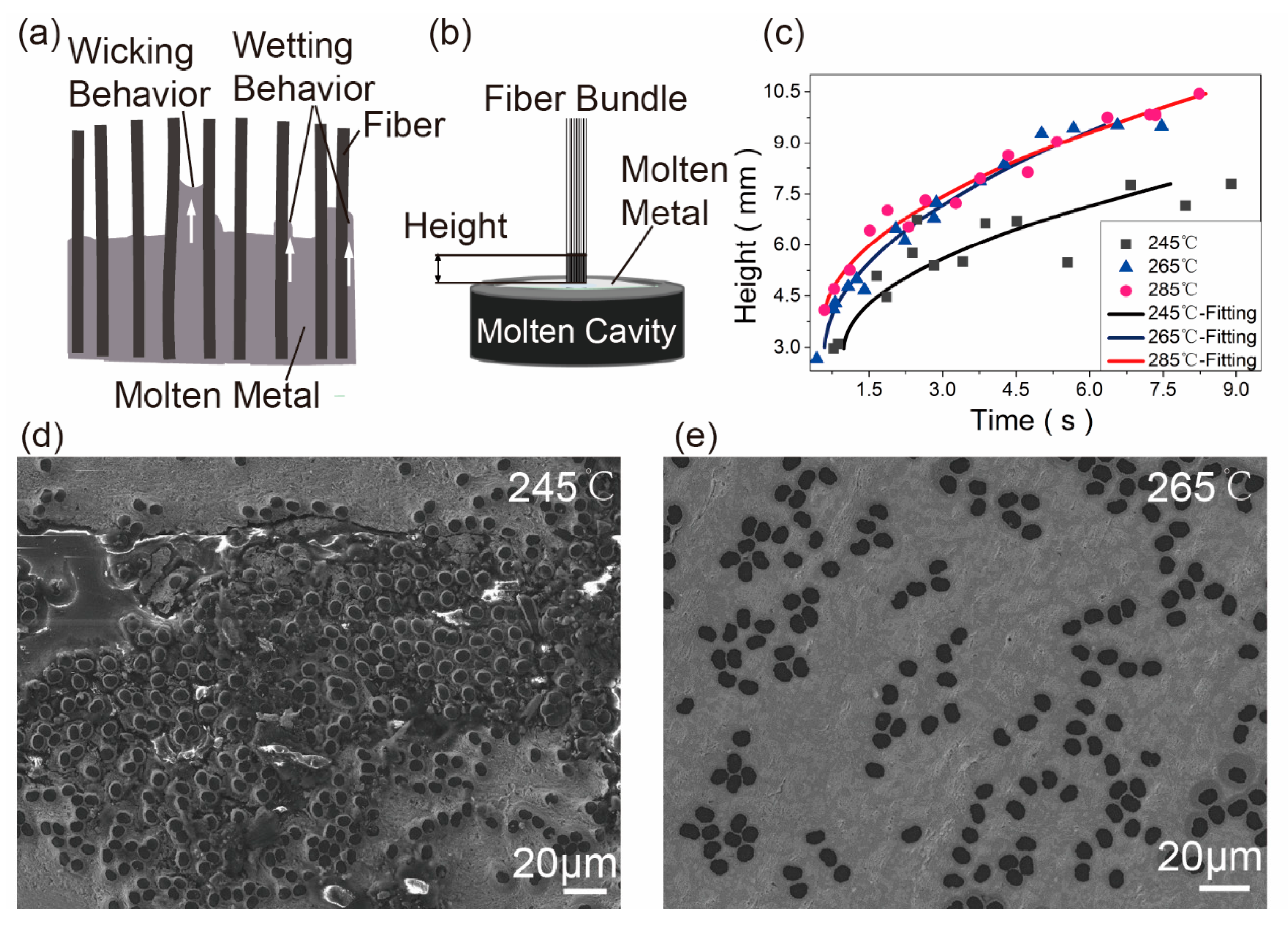3D Printing of Continuous Fiber Reinforced Low Melting Point Alloy Matrix Composites: Mechanical Properties and Microstructures
Abstract
:1. Introduction
2. Materials and Methods
2.1. 3D Printing Setup
2.2. Materials and Fiber Pretreatment
2.3. Sample Preparation
2.4. Characterizations
3. Results and Discussions
3.1. Mechanical Properties and Microstructure
3.1.1. Influence of Process Parameters on Tensile Strength
3.1.2. Fracture and Interfacial Microstructures
3.2. Discussions
3.2.1. Wicking Behavior on Fiber Bundles
3.2.2. Interfacial Reaction in 3D Printing Process
3.2.3. Demonstration of 3D Printed CF/Pb50Sn50 Parts
4. Conclusions
Supplementary Materials
Author Contributions
Funding
Acknowledgments
Conflicts of Interest
References
- Lu, K. The future of metals. Science 2010, 328, 319–320. [Google Scholar] [CrossRef] [PubMed]
- Hayat, M.D.; Singh, H.; He, Z.; Cao, P. Titanium metal matrix composites: An overview. Compos.Part A Appl. Sci. Manuf. 2019, 121, 418–438. [Google Scholar] [CrossRef]
- Sercombe, T.B.; Li, X. Selective laser melting of aluminium and aluminium metal matrix composites: Review. Mater. Technol. 2016, 31, 77–85. [Google Scholar] [CrossRef]
- Ramnath, B.V.; Elanchezhian, C.; Annamalai, R.M.; Aravind, S.; Atreya, T.S.A.; Vignesh, V.; Subramanian, C. Aluminium metal matrix composites—A Review. Rev. Adv. Mater. Sci. 2014, 38, 55–60. [Google Scholar]
- Wang, X.; Jiang, M.; Zhou, Z.W.; Gou, J.H.; Hui, D. 3D printing of polymer matrix composites: A review and prospective. Compos. Part B Eng. 2017, 110, 442–458. [Google Scholar] [CrossRef]
- Ming, Y.; Duan, Y.; Wang, B.; Xiao, H.; Zhang, X. A novel route to fabricate high-performance 3D printed Continuous fiber-reinforced thermosetting polymer composites. Materials 2019, 12, 1369. [Google Scholar] [CrossRef] [Green Version]
- Parandoush, P.; Lin, D. A review on additive manufacturing of polymer-fiber composites. Compos. Struct. 2017, 182, 36–53. [Google Scholar] [CrossRef]
- Tian, X.Y.; Liu, T.F.; Yang, C.C.; Wang, Q.R.; Li, D.C. Interface and performance of 3D printed continuous carbon fiber reinforced PLA composites. Compos. Part A Appl. Sci. Manuf. 2016, 88, 198–205. [Google Scholar] [CrossRef]
- Hou, Z.; Tian, X.; Zhang, J.; Li, D. 3D printed continuous fibre reinforced composite corrugated structure. Compos. Struct. 2018, 184, 1005–1010. [Google Scholar] [CrossRef]
- Mills, K.C.; Su, Y.C. Review of surface tension data for metallic elements and alloys: Part 1—Pure metals. Int. Mater. Rev. 2006, 51, 329–351. [Google Scholar] [CrossRef]
- Luo, X.; Yang, Y.; Yu, Y.; Wang, X.; Huang, B.; Chen, Y. Effect of Mo coating on the interface and mechanical properties of SiC fiber reinforced Ti6Al4V composites. Mater. Sci. Eng. A 2012, 550, 286–292. [Google Scholar] [CrossRef]
- Han, Y.Q.; Lin, C.F.; Han, X.X.; Chang, Y.P.; Guo, C.H.; Jiang, F.C. Fabrication, interfacial characterization and mechanical properties of continuous Al2O3 ceramic fiber reinforced Ti/Al3Ti metal-intermetallic laminated (CCFR-MIL) composite. Mat. Sci. Eng. A Struct. 2017, 688, 338–345. [Google Scholar] [CrossRef]
- Zhang, W.; Yang, Y.Q.; Zhao, G.M.; Huang, B.; Feng, Z.Q.; Luo, X.; Li, M.H.; Lou, J.H. Investigation of interfacial reaction in SiC fiber reinforced Ti–43Al–9V composites. Intermetallics 2013, 33, 54–59. [Google Scholar] [CrossRef]
- Zhou, Y.; Wang, Q.; Han, X.L.; Sun, D.L. Fabrication and properties of continuous unidirectional Mo fiber reinforced TiAl composites by slurry casting and vacuum hot pressing. Compos. Sci. Technol. 2013, 83, 72–78. [Google Scholar] [CrossRef]
- Shirvanimoghaddam, K.; Hamim, S.U.; Karbalaei Akbari, M.; Fakhrhoseini, S.M.; Khayyam, H.; Pakseresht, A.H.; Ghasali, E.; Zabet, M.; Munir, K.S.; Jia, S.; et al. Carbon fiber reinforced metal matrix composites: Fabrication processes and properties. Compos. Part A Appl. Sci. Manuf. 2017, 92, 70–96. [Google Scholar] [CrossRef]
- Hong, C.J.; Kim, J.B. A study of comfort performance in cotton and polyester blended fabrics. I. Vertical wicking behavior. Fibers Polym. 2007, 8, 218–224. [Google Scholar] [CrossRef]
- Nyoni, A.B.; Brook, D. Wicking mechanisms in yarns-the key to fabric wicking performance. J. Text. Inst. 2006, 97, 119–128. [Google Scholar] [CrossRef]
- Singh, B.B.; Balasubramanian, M. Processing and properties of copper-coated carbon fibre reinforced aluminium alloy composites. J. Mater. Process. Tech. 2009, 209, 2104–2110. [Google Scholar] [CrossRef]
- Qi, L.H.; Ma, Y.Q.; Zhou, J.M.; Hou, X.H.; Li, H.J. Effect of fiber orientation on mechanical properties of 2D-C-f/Al composites by liquid-solid extrusion following Vacuum infiltration technique. Mat. Sci. Eng. A Struct. 2015, 625, 343–349. [Google Scholar] [CrossRef]
- Wedi, A.; Baither, D.; Schmitz, G. Contact angle and reactive wetting in the SnPb/Cu system. Scripta Mater. 2011, 64, 689–692. [Google Scholar] [CrossRef]
- Liu, C.Y.; Tu, K.N. Morphology of wetting reactions of SnPb alloys on Cu as a function of alloy composition. J. Mater. Res. 1998, 13, 37–44. [Google Scholar] [CrossRef]
- Kaur, S.; Kaur, A.; Singh, P.S.; Singh, T. Scope of Pb-Sn binary alloys as gamma rays shielding material. Prog. Nucl. Energy 2016, 93, 277–286. [Google Scholar] [CrossRef]
- Sharma, R.; Sharma, J.; Singh, T. Effective atomic numbers for some alloys at 662 keV using gamma rays backscattering technique. Phys. Sci. Int. J. 2016, 11, 1–6. [Google Scholar] [CrossRef]
- ASTM D3552-1996(2007). Standard Test Method for Tensile Properties of Fiber Reinforced Metal Matrix Composites; ASTM: West Conshohocken, PA, USA, 2007. [Google Scholar]
- Wang, X.; Tian, X.Y.; Lian, Q.; Li, D.C. Fiber traction printing: A 3D printing method of continuous fiber reinforced metal matrix composite. Chin. J. Mech. Eng. 2020, 33, 1–11. [Google Scholar] [CrossRef] [Green Version]
- Luo, M.; Tian, X.; Zhu, W.; Li, D. Controllable interlayer shear strength and crystallinity of PEEK components by laser-assisted material extrusion. J. Mater. Res. 2018, 33, 1632–1641. [Google Scholar] [CrossRef]
- Pucci, M.F.; Liotier, P.J.; Drapier, S. Capillary effects on flax fibers—Modification and characterization of the wetting dynamics. Compos. Part A Appl. Sci. Manuf. 2015, 77, 257–265. [Google Scholar] [CrossRef]
- Washburn, E.W. Note on a method of determining the distribution of pore sizes in a porous material. Proc. Natl. Acad. Sci. USA 1921, 7, 115–116. [Google Scholar] [CrossRef] [Green Version]
- Guo, Z.N.; Hindler, M.; Yuan, W.X.; Mikula, A. The density and surface tension of In-Sn and Cu-In-Sn alloys. Monatsh. Chem. 2011, 142, 579–584. [Google Scholar] [CrossRef]
- Gasior, W.; Moser, Z.; Pstrus, J. Density and surface tension of the Pb-Sn liquid alloys. J. Phase Equilibria 2001, 22, 20–25. [Google Scholar] [CrossRef]
- Ho, C.T. Nickel- and copper-coated carbon fibre reinforced tin-lead alloy composites. J. Mater. Sci. 1996, 31, 5781–5786. [Google Scholar] [CrossRef]









| Coating Thickness μm | Quantity of Individual Fibers | Tensile Strength MPa | Tensile Modulus GPa | |
|---|---|---|---|---|
| Cu-CF | 2.0(Cu)+1.0(Ni) | 1K | 2900 | 230 |
| Pb50Sn50 | / | / | 33.3 | 8 |
| Group | Layer Height mm | Printing Temperature °C | Printing Speed mm/s | Wire Feed Ratio % |
|---|---|---|---|---|
| 1 | 0.3 | 265 | 1, 2, 3, 4, 5 | 11 |
| 2 | 0.3 | 255, 265, 275, 285 | 3 | 11 |
| λ W/m∙°C | ΔT °C | L mm | l mm | Sn mm2 | v mm/s |
|---|---|---|---|---|---|
| 401 | 240 | 2325 | 45 | 1 | 1, 3, 5 |
| Printing Speed mm/s | Porosities | Q kJ | |
|---|---|---|---|
| Gas Porosities | Fiber Porosities | ||
| 1 | 1.64% | / | 4.97 |
| 3 | 1.22% | 2.84% | 1.66 |
| 5 | 2.56% | 11.92% | 0.99 |
| Printing Temperature °C | Printing Speed mm/s | Original Coating Thickness μm | Interfacial Layer Thickness μm | Standard Deviation μm |
|---|---|---|---|---|
| 255 | 3 | 3 | 1.345 | 0.170 |
| 265 | 3 | 3 | 1.327 | 0.225 |
| 275 | 3 | 3 | 1.326 | 0.148 |
| 285 | 3 | 3 | 1.333 | 0.133 |
| 265 | 1 | 3 | 1.848 | 0.630 |
| Number | Compositions (at %) | Possible Phases | ||||
|---|---|---|---|---|---|---|
| Sn | Pb | Cu | Ni | C | ||
| Microarea 1 | 95.73 | 4.27 | Sn-rich | |||
| Microarea 2 | 50.77 | 3.68 | 45.56 | Cu6Sn5 | ||
| Microarea 3 | 46.21 | 53.79 | Pb-rich | |||
| Microarea 4 | 25.18 | 19.14 | 31.11 | 24.58 | Cu6Sn5, Ni | |
| Microarea 5 | 100 | Cu | ||||
| Microarea 6 | 2.45 | 97.55 | Ni | |||
| Microarea 7 | 2.05 | 11.74 | 86.21 | C | ||
| Printing Speed mm/s | Cu+Cu6Sn5 Thickness μm | Interfacial Thickness μm | Content % | Tensile Strength MPa |
|---|---|---|---|---|
| 1 | 1.200 | 1.848 | 64.96 | 188.7 |
| 3 | 0.607 | 1.372 | 45.75 | 236.7 |
© 2020 by the authors. Licensee MDPI, Basel, Switzerland. This article is an open access article distributed under the terms and conditions of the Creative Commons Attribution (CC BY) license (http://creativecommons.org/licenses/by/4.0/).
Share and Cite
Wang, X.; Tian, X.; Yin, L.; Li, D. 3D Printing of Continuous Fiber Reinforced Low Melting Point Alloy Matrix Composites: Mechanical Properties and Microstructures. Materials 2020, 13, 3463. https://doi.org/10.3390/ma13163463
Wang X, Tian X, Yin L, Li D. 3D Printing of Continuous Fiber Reinforced Low Melting Point Alloy Matrix Composites: Mechanical Properties and Microstructures. Materials. 2020; 13(16):3463. https://doi.org/10.3390/ma13163463
Chicago/Turabian StyleWang, Xin, Xiaoyong Tian, Lixian Yin, and Dichen Li. 2020. "3D Printing of Continuous Fiber Reinforced Low Melting Point Alloy Matrix Composites: Mechanical Properties and Microstructures" Materials 13, no. 16: 3463. https://doi.org/10.3390/ma13163463




